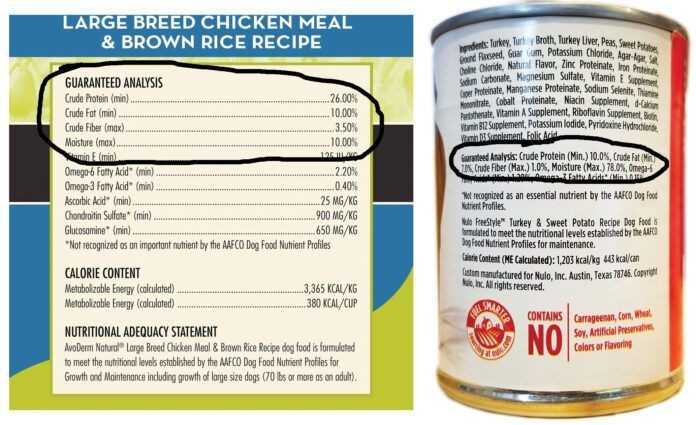Are you struggling to figure out How To Compare Dog Foods effectively? At COMPARE.EDU.VN, we simplify the process of comparing different dog food options, focusing on key nutritional information to help you make an informed choice for your furry friend. By understanding dry matter analysis and nutritional content, you can select the best food to keep your dog healthy and happy. Discover optimal canine nutrition and quality pet food analysis on COMPARE.EDU.VN.
1. Understanding the Guaranteed Analysis on Dog Food Labels
Every dog food label comes with a “guaranteed analysis,” which is required by federal and state laws. This analysis includes the minimum percentages of crude protein and crude fat, as well as the maximum percentages of crude fiber and moisture present in the food “as fed.”
- Crude Protein and Crude Fat: These are guaranteed minimums because protein and fat are essential and costly nutrients for dogs.
- Crude Fiber and Moisture: These are listed as maximums to indicate the highest amount of non-nutrient content in the food.
All these amounts are monitored by feed control officials in each state where the product is sold.
1.1. Minimums, Maximums, and Actual Amounts
It’s crucial to remember that the guaranteed analysis provides only minimum and maximum values. The actual nutrient content can vary significantly. For instance, a label might guarantee a minimum of 8% fat, but the food could contain 15% or more. Similarly, a maximum fiber guarantee of 5% might mean the product contains only 1%.
1.2. Typical Nutrient Analysis
Some manufacturers offer a “typical nutrient analysis,” providing more accurate nutrient values. These analyses can be based on computer calculations of the ingredients or laboratory tests. The most transparent companies publish these analyses on their websites, while others provide them upon request. Some companies may not offer this information at all.
If your dog requires a specific amount of protein, fat, or fiber due to health reasons (e.g., kidney issues, pancreatitis, constipation), it’s best to choose foods with readily available typical nutrient analyses.
1.3. As-Fed vs. Dry Matter Basis
For precise comparisons, look for nutrient contents listed in both “as-fed” and “dry matter” forms. “As-fed” refers to the food as it is packaged, while “dry matter” shows nutrient levels if all moisture were removed. This is especially important when comparing different types of dog food (canned, dry, etc.).
2. The Importance of Dry Matter Values in Dog Food Comparison
Have you ever wondered why canned dog food seems to have lower protein and fat percentages compared to dry food? A high-quality dry food might list 28% protein, while a comparable canned food shows only 7%. The key to understanding this difference lies in the “dry matter” values.
2.1. Comparing Different Types of Dog Food
Canned and fresh/frozen foods often contain more fat and protein than dry foods when you consider dry matter values. Different types of dog food have varying moisture contents, which affect the “as fed” percentages. The nutrient levels in high-moisture foods are diluted.
2.2. Calculating Dry Matter (DM)
To compare nutrient levels across different food types, you need to remove the moisture content mathematically:
-
Subtract the moisture percentage from 100 to find the dry matter (DM) factor:
100 − moisture % = dry matter or DM factor -
Divide the nutrient percentage by the DM factor to determine its dry matter percentage:
Protein % ÷ DM factor = DM protein -
Multiply by 100 to express as a percentage.
2.2.1. Example Calculation: Dry Dog Food
 Photo of a canned dog food label with the protein and carbohydrates circled.
Photo of a canned dog food label with the protein and carbohydrates circled.
-
Protein (min): 28%
-
Moisture (max): 9%
- Calculate DM factor:
100 - 9 = 91 - Calculate DM protein:
28 ÷ 91 = 0.31 - Dry matter protein: 31%
- Calculate DM factor:
2.2.2. Example Calculation: Canned Dog Food
-
Protein (min): 7%
-
Moisture (max): 78%
- Calculate DM factor:
100 - 78 = 22 - Calculate DM protein:
7 ÷ 22 = 0.31 - Dry matter protein: 31%
- Calculate DM factor:
In this example, both the dry and canned foods have the same dry matter protein content (31%), even though their “as fed” percentages differ significantly.
3. How to Calculate Carbohydrates in Dog Food
Carbohydrates are not usually listed in the guaranteed analysis, but you can calculate them easily by including the “ash” content in your calculations.
3.1. Understanding Ash Content
Ash is the mineral content remaining after burning the food. It includes minerals like calcium, phosphorus, iron, copper, zinc, magnesium, and selenium.
- Quality Indicator: High-quality foods often have lower ash levels (around 5-9%), while low-quality foods can have ash levels of 10% or higher. High ash content can hinder nutrient absorption.
3.2. Calculating Carbohydrates
To calculate the carbohydrate percentage:
- Add the “as fed” percentages for protein, fat, fiber, moisture, and ash.
- Subtract the total from 100.
- Divide the result by the DM factor.
100 - (Protein % + Fat % + Fiber % + Moisture % + Ash %) ÷ DM factor = Carbohydrates %
If the ash content is not listed, estimate it as:
- 5-9% for canned or dry food
- 1-4% for fresh or frozen raw foods
3.2.1. Example Calculation: Finding Carbohydrates
-
Protein (min): 28%
-
Fat (min): 18%
-
Fiber (max): 3%
-
Moisture (max): 9%
-
Ash (max): 9%
- Add the percentages:
28 + 18 + 3 + 9 + 9 = 67 - Subtract from 100:
100 - 67 = 33 - Divide by the DM factor (91):
33 ÷ 91 = 0.36 - Carbohydrates: 36%
- Add the percentages:
4. Additional Examples and Considerations for Dog Food Comparison
Let’s explore more examples to reinforce the process and highlight the variability in dog food compositions.
4.1. Example: Raw Frozen Food
-
Crude protein: 12%
-
Crude fat: 11%
-
Crude fiber: 1%
-
Moisture: 72%
-
Ash: 3%
- Calculate DM factor:
100 - 72 = 28 - Calculate DM protein:
12 ÷ 28 = 0.43 (43%) - Calculate carbohydrates:
- Add percentages:
12 + 11 + 1 + 72 + 3 = 99 - Subtract from 100:
100 - 99 = 1 - Divide by DM factor:
1 ÷ 28 = 0.035 (3.5%)
- Add percentages:
- Calculate DM factor:
This raw food example demonstrates a very low carbohydrate content, typical of many raw diets. Dogs do not have a nutritional requirement for carbohydrates, and many thrive on low-carb diets.
4.2. Example: High-Carb Kibble
-
Crude protein: 21%
-
Crude fat: 10%
-
Crude fiber: 5%
-
Moisture: 12%
-
Ash (estimated): 6%
- Calculate DM factor:
100 - 12 = 88 - Calculate DM protein:
21 ÷ 88 = 0.24 (24%) - Calculate carbohydrates:
- Add percentages:
21 + 10 + 5 + 12 + 6 = 54 - Subtract from 100:
100 - 54 = 46 - Divide by DM factor:
46 ÷ 88 = 0.52 (52%)
- Add percentages:
- Calculate DM factor:
This example shows a high carbohydrate content, which is common in many commercial kibbles.
5. Key Factors to Consider When Choosing Dog Food
When choosing dog food, several factors should be considered beyond the basic nutrient calculations.
5.1. Ingredient Quality
The quality of ingredients is paramount. Look for whole food ingredients, named meat sources (e.g., chicken, beef, lamb), and avoid generic terms like “meat by-products.”
5.2. Specific Dietary Needs
Consider your dog’s specific needs based on age, breed, activity level, and health conditions. Puppies need food formulated for growth, while senior dogs may benefit from lower-calorie options. Dogs with allergies or sensitivities require specialized diets.
5.3. Reviews and Recommendations
Consult with your veterinarian and read reviews from other dog owners. Look for reputable sources that provide unbiased information.
5.4. Brand Reputation
Choose brands with a strong reputation for quality and safety. Research the company’s history, manufacturing processes, and quality control measures.
5.5. Cost
Balance cost with quality. While cheaper foods may seem appealing, they often contain lower-quality ingredients and may not meet your dog’s nutritional needs.
5.6. Life Stage Appropriateness
Ensure the food is appropriate for your dog’s current life stage. Puppy, adult, and senior formulas have different nutritional profiles to meet varying needs.
5.7. Protein Source
The primary protein source should be a high-quality animal protein. Look for foods where meat is listed as one of the first ingredients.
5.8. Fat Content
Fat is essential for energy and healthy skin and coat. The appropriate fat content varies depending on your dog’s activity level.
5.9. Fiber Content
Fiber aids digestion and helps maintain bowel regularity. The right amount of fiber depends on your dog’s digestive health.
5.10. Carbohydrate Source
Choose foods with digestible carbohydrates like brown rice, oats, or sweet potatoes. Avoid foods with excessive amounts of corn, wheat, and soy.
6. Practical Steps for Comparing Dog Foods
To make the comparison process more manageable, follow these practical steps:
- Gather Information: Collect the guaranteed analysis and typical nutrient analysis (if available) for the dog foods you are considering.
- Calculate Dry Matter Values: Convert the “as fed” percentages to dry matter values to ensure an accurate comparison.
- Compare Nutrient Profiles: Compare the protein, fat, fiber, and carbohydrate content on a dry matter basis.
- Evaluate Ingredients: Assess the quality of ingredients, looking for whole foods and named meat sources.
- Consider Your Dog’s Needs: Factor in your dog’s age, breed, activity level, and health conditions.
- Consult with Your Vet: Discuss your choices with your veterinarian to ensure the food meets your dog’s specific needs.
- Read Reviews: Check online reviews and seek recommendations from other dog owners.
- Monitor Your Dog’s Response: Once you choose a food, monitor your dog’s health and well-being. Look for signs of good digestion, healthy coat, and sustained energy levels.
7. Understanding Common Dog Food Myths
Several myths surround dog food, and debunking them can help you make better decisions.
7.1. Myth: Grain-Free is Always Better
While some dogs benefit from grain-free diets due to allergies or sensitivities, grains are not inherently harmful. Many grains provide valuable nutrients.
7.2. Myth: Raw Food is Always Superior
Raw food diets can be beneficial, but they also carry risks of bacterial contamination if not handled properly. Consult with your vet before switching to a raw diet.
7.3. Myth: By-Products are Always Bad
By-products can include nutritious organ meats. The quality of by-products varies, so research the brand and ingredients.
7.4. Myth: More Protein is Always Better
While protein is essential, excessive protein can strain the kidneys. The appropriate amount of protein depends on your dog’s needs.
7.5. Myth: All Dog Foods are Created Equal
Dog food quality varies significantly. Investing in a high-quality food can lead to better health and longevity for your dog.
8. Frequently Asked Questions (FAQ) About Comparing Dog Foods
Q1: Why is it important to compare dog foods on a dry matter basis?
Comparing dog foods on a dry matter basis ensures an accurate comparison by removing the effect of moisture content, which varies significantly between different types of food (e.g., dry vs. canned).
Q2: How do I calculate the dry matter protein content of dog food?
To calculate the dry matter protein content, divide the “as-fed” protein percentage by the dry matter factor (100 – moisture percentage).
Q3: What is ash in dog food, and why is it important?
Ash is the mineral content remaining after burning the food. Lower ash levels in high-quality foods indicate better nutrient absorption.
Q4: How can I calculate the carbohydrate content of dog food?
To calculate carbohydrates, add the “as-fed” percentages for protein, fat, fiber, moisture, and ash, subtract the total from 100, and divide the result by the dry matter factor.
Q5: What should I look for in the ingredient list of high-quality dog food?
Look for whole food ingredients, named meat sources (e.g., chicken, beef, lamb), and avoid generic terms like “meat by-products.”
Q6: Is grain-free dog food always better for my dog?
Not necessarily. Some dogs benefit from grain-free diets due to allergies or sensitivities, but grains are not inherently harmful and can provide valuable nutrients.
Q7: How do I choose the right dog food for my dog’s specific dietary needs?
Consider your dog’s age, breed, activity level, and health conditions. Consult with your veterinarian for personalized recommendations.
Q8: Are by-products in dog food always bad?
By-products can include nutritious organ meats. The quality of by-products varies, so research the brand and ingredients.
Q9: Can I switch dog food brands without causing digestive issues for my dog?
Gradually transition to the new food by mixing it with the old food over a period of 7-10 days to avoid digestive upset.
Q10: Where can I find reliable reviews and recommendations for dog food brands?
Consult with your veterinarian and read reviews from reputable sources that provide unbiased information.
9. COMPARE.EDU.VN: Your Partner in Making Informed Decisions
At COMPARE.EDU.VN, we understand the challenges of comparing dog foods and making informed decisions. Our platform provides comprehensive comparisons, detailed analyses, and valuable resources to help you choose the best food for your dog.
9.1. Easy-to-Use Comparison Tools
Our easy-to-use comparison tools allow you to quickly compare different dog food options side-by-side, focusing on key nutritional information and ingredient quality.
9.2. Expert Reviews and Analysis
Our team of experts provides unbiased reviews and analyses of various dog food brands, helping you understand the pros and cons of each option.
9.3. Personalized Recommendations
We offer personalized recommendations based on your dog’s specific needs, ensuring you make the best choice for their health and well-being.
9.4. Educational Resources
Our educational resources provide valuable information on canine nutrition, helping you become a more informed and confident dog owner.
Choosing the right dog food is a crucial decision that impacts your dog’s health and well-being. By understanding how to compare dog foods effectively, you can ensure your furry friend receives the optimal nutrition they need to thrive. Visit COMPARE.EDU.VN today to explore our comprehensive comparison tools, expert reviews, and personalized recommendations. Let us help you make the best choice for your beloved companion.
Ready to make an informed decision about your dog’s food? Visit COMPARE.EDU.VN today for comprehensive comparisons, expert reviews, and personalized recommendations. Your dog deserves the best, and we’re here to help you provide it.
Contact us:
Address: 333 Comparison Plaza, Choice City, CA 90210, United States
Whatsapp: +1 (626) 555-9090
Website: COMPARE.EDU.VN
Choose wisely, choose compare.edu.vn!

